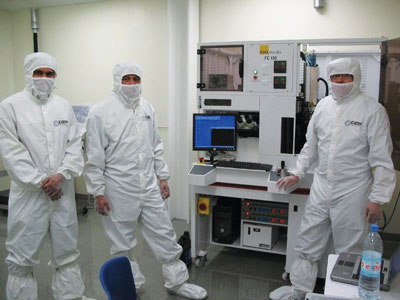| Feb 05, 2011 |
Sandia international agreement to assist Mexican MEMS students
|
|
(Nanowerk News) Sandia will help Mexican engineering students learn to design tiny microelectromechanical devices (MEMS), according to a memorandum of understanding recently signed by Sandia and the University of Guadalajara.
|
|
The rationale for the agreement is that the economic well-being of Mexico is a national security issue for the US, says Sandia project lead Ernest Garcia. "If we could help Mexico improve its research and development capabilities, it would help stabilize its economy," he says.
|
 |
| Students in the clean room at the Universidad Autónoma de Ciudad Juárez in its Centro de Investigación en Ciencia y Tecnología Aplicada are ready for serious work. Professor Jose Mireles, head of this research center, has worked with Sandia for some time. Sandia's MOU with the University of Guadalajara will open MEMS education opportunities to more Mexican students.
|
|
"Ultimately, the US may be the biggest beneficiary if the MOU contributes to the vitality of the Mexican economy and thereby the stability of the US-Mexican border," says Gil Herrera, director of Sandia's Microsystems Science, Technology, and Components Center 1700. "We believe that Sandia will also benefit from the relationship, as we will have new minds challenging the design envelope of our SUMMiT MEMS technology." Gil is in overall charge of Sandia's activities in support of the collaboration.
|
|
Sandia's SUMMiT V program, one of the most advanced in the world, will be available to help students design MEMS devices in five layers of silicon. Each layer adds another level of complexity to the design. MEMS devices currently control light, electricity, or fluid flow in today's video cameras, printers, recording devices, and televisions. They also react to motion shock by opening air bags in cars.
|
|
"The University of Guadalajara is like the state of California's higher education system," Ernie says. "It supports a number of universities throughout the Mexican state of Jalisco. Its leadership wants to use SUMMiT as the basis for a future graduate program in MEMS."
|
|
The Mexican interior
|
|
"MEMS manufacturing will leverage many of Mexico's traditional strengths in electronic manufacturing," says Gil. "Sandia is in a position to help the University of Guadalajara System migrate to a state-of-the-art MEMS design capability."
|
|
Steve Rottler, Sandia's VP for basic technologies (S&T & Research Foundations Div. 1000) who signed the agreement for Sandia, says, "We were very impressed by the commitment and enthusiasm of the University of Guadalajara faculty and leadership. We are excited about the opportunity to collaborate in the continued advancement of technologies that are vital to the economies of both countries, and to the prospect that this collaboration can contribute to improved security for both countries."
|
|
Similar efforts by Sandia are also underway at Mexican universities in Juarez, Vera Cruz, and Mexico City, as well as the Puebla-based national research institute INAOE (National Institute of Astrophysics, Optics, and Electronics).
|
|
The agreement extends earlier work by Sandia, which played a role in creating a Bi-National Sustainability Laboratory on the border of the United States and Mexico. That effort was intended to examine issues of interest on both sides of the border, like water rights. Research efforts were expected ultimately to create industries and jobs at the border to staunch the one-way flow of workers from Mexico to the United States. That effort is now directed by an independent nonprofit corporation with a variety of sponsors.
|
|
The Guadalajara agreement is different, says Ernie, because it (and other Sandia university efforts) are in the interior of Mexico rather than its outskirts.
|
|
"We hope eventually to have Mexican universities compete in Sandia's University Alliance annual MEMS competition for the most imaginative or practical designs," Ernie says. Student contest winners get to see their designs become reality through fabrication at Sandia's MEMS fabrication facilities.
|
|
Not a sprint but a marathon
|
|
But to reach that goal for Mexican students, he says, will require patience. "It's not a sprint, it's a marathon," Ernie says, mentioning potential barriers like US controls on exporting technology and intellectual property to foreign countries.
|
|
A delegation of Mexican professors from Guadalajara will visit Albuquerque next spring to confer with researchers at Sandia and possibly the University of New Mexico. The trips will be funded by the state of Jalisco's technology office. (Albuquerque and Guadalajara are designated so-called "sister cities.")
|
|
The Guadalajara program is expected to expand an already-existing Sandia-led national MEMS project for Mexico, funded by that country with $2 million. "Last December, a number of Mexican professors took our MEMS course, licensed our design software, and purchased 100 silicon chips with their MEMS designs," Ernie says.
|

